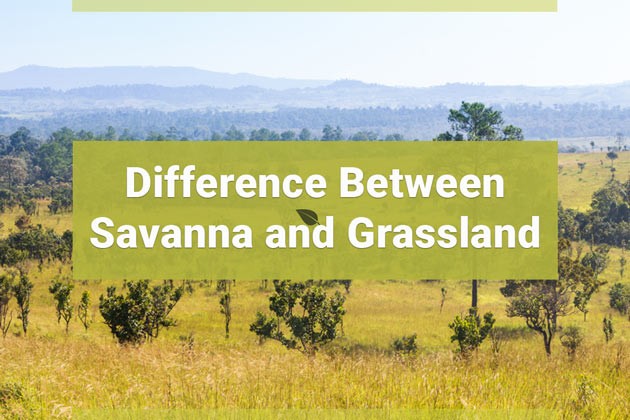Grasslands and savannas are often mistaken for one another due to their dominant vegetation: grasses. Both ecosystems play crucial roles in the global environment, supporting diverse wildlife and influencing regional climates. However, beneath the surface similarities lie significant differences that define each biome. This article will delve into a detailed comparison of savannas and grasslands, exploring their unique characteristics, locations, climates, vegetation, and soil compositions to highlight what sets them apart.
 Savanna versus Grassland comparison showing landscape differences
Savanna versus Grassland comparison showing landscape differences
The term “grassland” broadly describes vast expanses of land where grasses are the primary form of vegetation. These areas experience moderate rainfall, insufficient to support dense forests but enough to prevent desertification. Grasslands are characterized by open landscapes with grasses and occasional shrubs. Savannas, sometimes referred to as “tropical grasslands,” are a specific type of grassland found in warmer climates. While also grass-dominated, savannas are distinguished by the presence of scattered trees. These trees, however, are not densely packed enough to form a closed canopy like in a forest, creating a unique mosaic of grassy areas interspersed with woody vegetation. Let’s explore the defining traits of each ecosystem to understand their distinct identities.
What is a Savanna?
A savanna is a tropical or subtropical grassland ecosystem characterized by a mix of grasses and scattered trees. Ecologically, savannas represent a transitional zone between rainforests and deserts. This geographical positioning dictates their climate, which is marked by distinct wet and dry seasons. The savanna biome is primarily found in regions with alternating wet and dry periods, a climate pattern driven by tropical weather systems.
Savannas typically experience warm temperatures year-round, averaging around 86 degrees Fahrenheit (30 degrees Celsius) during the warmer months. The defining climatic feature is the seasonality of rainfall. Savannas have a pronounced wet season, typically during the summer months, followed by a prolonged dry season. This seasonal rainfall pattern is crucial in shaping the savanna environment, influencing vegetation types and animal adaptations. The soil in savannas is often clay-rich and less fertile compared to grasslands, which impacts the types of plants that can thrive.
What is a Grassland?
Grasslands, also known as temperate grasslands, are expansive areas primarily covered in grasses, with a notable absence of trees. These biomes are found in temperate zones, experiencing a wider range of temperature variations throughout the year compared to savannas. The lack of significant tree cover in grasslands is primarily due to lower rainfall levels than savannas and other factors such as seasonal drought and fire regimes.
Temperate grasslands are characterized by distinct seasons, with hot summers and cold winters. Temperature fluctuations can be extreme, with summer temperatures potentially exceeding 140 degrees Fahrenheit (60 degrees Celsius) and winter temperatures dropping below freezing. This seasonal temperature variation is a key differentiator from savannas. Grassland soils are typically dark brown and highly fertile, often referred to as mollisols. This rich soil is a significant asset for agriculture, making grasslands important agricultural regions. The deep root systems of grasses in these areas contribute to soil health and resilience, enabling them to survive seasonal droughts and temperature extremes.
Savannas vs. Grasslands: Key Distinctions
While both savannas and grasslands are dominated by grasses, the crucial difference lies in the presence and density of trees. Savannas are grasslands with trees; however, these trees are sparsely distributed. Grasslands, in contrast, are largely treeless landscapes. This difference in tree density stems from variations in rainfall and climate.
Savannas, being tropical grasslands, generally receive more rainfall than temperate grasslands. This higher rainfall supports the growth of scattered trees alongside grasses. Temperate grasslands receive less rainfall and experience more extreme temperature variations, conditions that are less conducive to tree growth. The seasonal climate variations in temperate grasslands, with cold winters and hot summers, further limit tree establishment, favoring grasses and herbaceous plants that are adapted to these conditions.
The table below summarizes the main differences between savannas and grasslands:
| Feature | Savanna | Grassland |
|---|---|---|
| Characteristics | Grassy landscapes with scattered trees | Grass-dominated, largely treeless landscapes |
| Types | Wet, dry, thornbush savannas | Steppes, prairies, pampas, downs |
| Locations | Africa, India, South America, Australia | North America, Eurasia, Argentina, Australia, New Zealand |
| Climate | Wet and dry seasons, warm temperatures | Hot summers, cold winters, temperature variations |
| Precipitation | Higher rainfall (20-40 inches/year) | Lower rainfall (10-30 cm/year) |
| Vegetation | Grasses and scattered trees (acacia, baobab) | Primarily grasses (needlegrass, buffalo grass) |
| Soil | Less fertile, clay-rich | Highly fertile, mollisols |
Conclusion
Savannas and grasslands are vital biomes that showcase the diversity of terrestrial ecosystems. While both are grass-dominated landscapes, the presence of scattered trees, driven by differences in climate and rainfall, distinguishes savannas from grasslands. Grasslands are characterized by their vast, treeless expanses and seasonal temperature variations, while savannas offer a more diverse landscape with a mix of grasses and trees in warmer, seasonally wet and dry climates. Both biomes support unique wildlife and play critical roles in global ecology, highlighting the importance of understanding and conserving these valuable natural environments.
